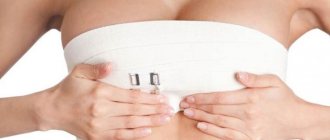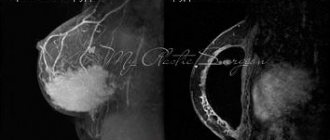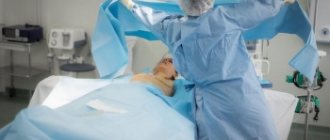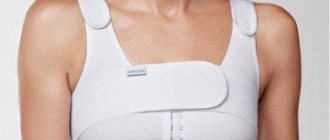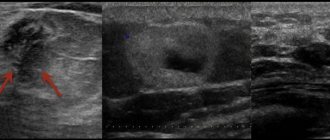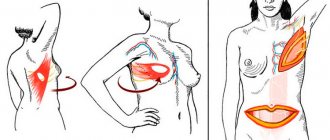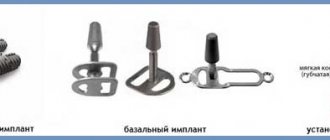Girls who decide to undergo mammoplasty - bust enlargement or correction using silicone implants, first of all, do not want to see additional scars on the body. This requirement determines the high aesthetics of plastic surgery. However, it is important to understand that you cannot do without scars.
Proper care of sutures after surgery is the basis for a quick recovery after surgery. Plastic surgeons pay special attention to this point of the rehabilitation program. Although this process is individual for each patient, there are general recommendations for care.
We will talk about the modern technology of “suture gluing”, how to properly care for scars, how you can speed up their healing, and show what scars look like after breast augmentation at different stages of rehabilitation.
Sutures after mammoplasty: their types and features
To install breast implants, a plastic surgeon needs to create access - make a tissue incision in the selected location. Please note that the choice of access is always determined individually during a consultation. All nuances are taken into account: the initial condition of the mammary gland, height and weight.
When performing breast augmentation, the incision is made in those areas where it will be as invisible as possible: in the inframammary fold, along the lower edge of the areola or through the armpit.
In aesthetic plastic surgery, three types of approaches for breast augmentation are common:
- submammary (the incision passes under the bust in a natural fold of the skin). This access is considered the most universal. The seams after mammoplasty in this area are invisible and are well hidden by underwear;
- periareolar (incision is made along the lower border of the areola). The border between light and dark skin allows the seams to have an aesthetic appearance and quickly become invisible;
- axillary (access is performed in the axillary area). This method for installing implants is often called “sutureless.” The seam in the armpit after healing almost completely merges with the natural color of the body. And, of course, there are no scars on the chest.
Sutures after mammoplasty are a thin cosmetic suture that tightens the edges of the surgical wound for speedy healing. There are several types:
- normotrophic. They represent an area of skin that is slightly lighter than the base color of the fabric and cannot be felt at all when touched. To ensure that the seams are completely even in shade, cosmetic peeling or laser resurfacing of scars using the latest generation Fotona laser is sufficient;
- hypertrophic. These scars are pink in color and protrude slightly above the surface of the skin. To completely smooth them out, peelings and laser resurfacing are used;
- keloids. These are the most difficult stitches after mammoplasty. Outwardly, they look rough, compacted, stand out with pigmentation and can be painful when touched.
Treatment of rough scars
Treatment of rough scars can be either medicinal or surgical.
Surgical treatment involves excision of the scar with plastic surgery using local tissue. There are many methods of scar plastic surgery, which are selected for each specific case.
Drug treatment includes wearing special patches and using ointments that block the excessive formation of connective tissue.
In particularly severe cases, when the scar continues to hypertrophy, glucocorticoid drugs are used in injection form. Such drugs must be used carefully so as not to transform a hypertrophic scar into an atrophic one.
Why do keloid scars appear?
Keloid scars are a complication of breast augmentation. Among the reasons for their formation are the following:
- features of the body's immune system,
- hereditary predisposition,
- excessive skin tension in the healing zone,
- suppuration or infection of a postoperative wound.
It should be noted that sutures after mammoplasty rarely turn into keloids. This process mainly has a hereditary predisposition and manifests itself gradually, in some cases up to 2 years. Therefore, with constant monitoring by a doctor, you can notice changes occurring in time and stop their development.
Prevention of scar formation
- During the operation, try to minimize the tension on the postoperative sutures. Of course, the very meaning of a brace contradicts this, but we must remember that the tension should be reasonable.
- Breast lifts larger than size 4 will typically have more tension and therefore rougher scarring.
- Careful handling of soft tissues during surgery. It depends entirely on the surgeon.
- Careful suturing of the postoperative wound. Also, the care of the surgeon, but not always the most careful suturing of a postoperative wound guarantees a high-quality scar.
Seam gluing during breast augmentation
Today, plastic surgery is developing exponentially. And the main goal of a plastic surgeon is to make scars as invisible as possible. Specialists use innovative technology of “seam gluing”. Its essence lies in the use of special medical glue for the skin. By the way, the seam gluing technique is often called the “seamless method of breast augmentation.” How does this happen?
In the operating room, the plastic surgeon applies a cosmetic suture to the wound using absorbable suture. This is an important point! Do not believe if they tell you that the edges of the wound will only be glued together with glue. There are always stitches! This is usually an absorbable thread, so the stitches are not removed after breast augmentation.
Only a stitched wound can be sealed by a plastic surgeon with glue. It is applied to the seam. In fact, medical glue acts as a kind of “plaster” that protects the wound and suture.
Advantages of seam gluing after mammoplasty:
- maximum protection of the seam from the external environment, bacteria and weathering;
- the seams do not require care;
- obtaining a high aesthetic result.
The scar after breast augmentation, made using the “suture gluing” technique, looks the same after 1 month as it did after 6-8 months. By the way, seam gluing is used for a tummy tuck (abdominoplasty).
FAQ
What to do with training if pain occurs?
You can continue to exercise, but exercises that cause pain should be avoided for a while.
If sharp painful sensations or significant discomfort appear, you need to stop all training and see a doctor.
Chest discomfort during exercise, what is the reason?
During the first 2-3 weeks, discomfort is acceptable. It is especially pronounced if a larger implant is inserted. The surgeon inserts it under the large chest muscle, where there is not enough room. The implant puts pressure on the surrounding tissue, stretching it. Over time, adaptation occurs.
To get the breasts of your dreams, work with reputable plastic surgeons. Butko Plastic will conduct an examination and the doctor will select implants. We use safe anesthesia and modern equipment. We use only proven developments. Call and make an appointment with Igor Butko now. Take the first step towards the breasts of your dreams.
How to reduce a scar after mammoplasty?
If you still have scars after breast surgery that are not aesthetically pleasing to you, then you can resort to reducing them. Often girls turn to cosmetologists who offer procedures that can reduce the appearance of scars. These are peelings, microdermabrasion and laser resurfacing. Today, patients are most often offered laser scar resurfacing - this is the most reliable method of eliminating them. For example, you can do resurfacing using the latest generation Fotona laser.
How to prevent the double breast effect
The most important thing for preventing such complications during mammoplasty is choosing an experienced surgeon who will take into account all the anatomical features of the breast and correctly develop surgical tactics. The experience and qualifications of the specialist are important, as well as the clinic’s equipment, implants of different types and sizes, which are individually selected for each patient.
A competent specialist will determine the future location of breast implants, the method of their installation and the area of incisions.
You first need to conduct a full examination before surgery, as well as meticulous adherence to the milestones of rehabilitation and medical recommendations.
It is also important to wear compression garments to prevent the prosthesis from drooping and to form the correct bed for it. Underwear will need to be selected together with the doctor and worn exactly as long as the doctor deems necessary.
Pain after surgery
Many girls worry about the sensations that may occur after breast augmentation. They are afraid of pain. In fact, there is no pain, there is discomfort, which can be compared to soreness after playing sports. There are also limitations in hand mobility. Immediately after the operation, it is difficult to raise your arms up, put on a jacket on your own, or even cut bread. But over time, this discomfort fades away.
In the early postoperative period, the breast remains swollen, there is a feeling of numbness, and there may also be “squelching” in the mammary gland.
Suture after mastopexy
The placement of sutures after a breast lift depends on the type of surgery performed.
- Vertical. The sutures run along the outer contour of the areola and then vertically down to the inframammary fold. The most noticeable is the vertical scar, and the scar along the areola is visible only upon careful examination
- Periareolar. Sutures are placed along the outer contour of the areola
- Anchor. The stitches are laid along the outer contour of the areola, then down vertically to the inframammary fold, after which they run along the fold under the breast. The stitches after this type of operation are the most noticeable, but this technique is also considered the most effective.
⇒
How to care for seams?
Every patient, before stepping into the operating room, must understand that thin and barely noticeable scars after surgery will remain in any case. But thanks to proper and careful care, they can be made unnoticeable. Here is a list of basic recommendations on how to handle sutures after mammoplasty:
- Smoking is strictly not recommended during the period of preparation for the intervention and until final rehabilitation.
- It is mandatory to wear compression garments for up to six weeks after the surgical procedure.
- During the first week, contact with water is prohibited - the sutures after mammoplasty must be kept dry during this period.
- After hygiene procedures, it is necessary to apply a moisturizing cream or lotion to the stitches to avoid drying out the skin and to maintain its elasticity.
- For the first 2 months after surgery, physical activity on the shoulder girdle of muscles should be limited.
How does a breast augmentation consultation work?
Goals:
- acquaintance and establishment of a trusting understanding between the patient and the doctor;
- collection of necessary anamnestic data;
- determining the expected outcome of the operation and the patient’s motivations;
- discussion of the features of the operation and the postoperative period, possible complications, for example, analysis of some clinical cases from the surgeon’s practice;
- determining future breast volume using external sizers;
- measuring the main dimensions of the chest and chest, taking into account anatomical features;
- selection of implants based on the analysis;
- photo demonstration of the results of operations performed and their analysis;
- written documentation of the consultation, handed over with the examination plan;
- 3D modeling.
“And why do they ask me about everything in such detail...?”
During the consultation, the doctor asks questions that are directly related to the planned operation or its preparation. For example, typical questions include:
- Have you ever been satisfied with your breasts?
- How do your loved ones feel about your intentions?
- How long have you been thinking about breast surgery?
- Are you planning a pregnancy in the near future?
- Do you have any children ?
- Have you breastfed and if yes, for how long?
- What was the maximum breast size and which breast had the most milk?
- What changes have happened to your breasts?
- Are there any difficulties when choosing underwear?
- Is your weight stable?
- How do breasts change during menstruation?
- Have you had any plastic surgery and if yes, how do you like the result or what surgeries might you still be planning?
- Maybe someone you know has already had breast surgery?
“Now I remember, when was the last time I saw a doctor...?”
Information about previous or existing diseases may indicate the presence of contraindications to surgery. Observation by specialized specialists or ongoing treatment may also require additional examination.
It is advisable to carry out an examination of the mammary glands once a year, for example, the simplest is an ultrasound of the mammary glands.
“Here, doctor, look what I want... but I don’t like it this way...!”
Also during the consultation, it is important to carefully study the patient’s wishes and the expected result. You can tell us about the breast shape and size you dream about. Patients often bring photographs of their breasts that they like, for example, photographs of models, which also helps to more clearly determine the size and shape of the breast. This also helps to understand what result of the operation you would not like to receive.
Remember that with a responsible attitude to planning the operation, you will always be satisfied with the result. Being informed before surgery helps you make the right decisions.
“And on Monday I have to go to work... but can I go to the gym...?”
Of great importance is information about the features of the postoperative period, which usually proceeds smoothly and quickly. After just two to three weeks, patients “forget” about the operation. In fact, the healing processes in tissues continue much longer, for example, fixation of an implant in tissues and ingrowth of connective tissue into its shell occurs within 3-5 months. Wearing compression garments prevents sagging and displacement of the implant and helps to refine the shape of the breast after surgery or reduce asymmetry. Limited loads on the shoulder girdle, for example, swimming a month after surgery, help to form a more delicate capsule around the implant, while more intense loads are recommended from the 2-3rd month. After the operation, it is necessary to conduct an ultrasound examination after 2, 6 and 12 months, then every year. Of great importance is the concept that the breast is a dynamic organ and can change over time. All this knowledge gained during the consultation helps you get not only a beautiful, but also a stable result that you will be happy with for the rest of your life. You will also be able to see real implants from various manufacturers, hold them in your hands, and test them for strength (usually each surgeon has many implants, which he will definitely tell you about).
“This is what I like best... what about you, doctor?”
How can you see future breasts? A set of external sizers of different sizes, which are inserted into a specially selected elastic T-shirt, is effectively suitable for this. Thanks to this simple technique, the patient can see in the mirror how proportionally the selected breast volume suits her. Sizers accurately convey the volume and weight of implants and significantly help visualize the result of the operation. Using sizers, you can also determine the size of your future bra cup using a special table.
External sizers
Trying on external sizers before surgery
Result after surgery
“... really a little lower on the left... I didn’t even notice this before?!”
The next stage of the consultation is to measure the size of the breast and rib cage, taking into account anatomical features. You will have to strip to the waist! Of great importance to achieve a stable result of the operation is the selection of an implant in accordance with the size of the original breast. An implant extending beyond the surface tissue can be palpated and visually noticeable. Recently, most patients strive for naturalness when planning surgery. As a rule, every patient has asymmetry, this is also taken into account during the consultation. It can be caused by different heights of the areolas or the inframammary fold located at different levels, or different volumes of the gland's own tissues. Noticeable asymmetry in some cases can be corrected, for example, by selecting different-sized implants or internal tissue transposition, or a slight displacement of one of the inframammary folds. And a small unaccounted for asymmetry, which could have been prevented, may become noticeable after surgery, due to a change in the position of the breast tissue on the implant after surgery. Asymmetry can also be a result of scoliosis.
It is important to assess the volume of covering tissue above the implant; for example, with thin skin and a small amount of fatty tissue in the lateral sections, the implant can be palpated. This sensation can be easily demonstrated by placing 3-4 layers of thick material equal in thickness to your tissues on the edge of the implant.
Therefore, in such cases, it is rational to carry out the lipofilling procedure (injection of one’s own fat) 8-12 months after the operation.
The most important dimensions: girth under the breast, distance from the nipple to the inframammary fold and to the base of the neck, width of the chest area, measurement of the thickness of the integumentary tissue, height. Usually, all measurements taken are drawn on the skin of the chest with a thin marker (you will see everything in the mirror) and washed off after the consultation.
Breast measurement before surgery
Breast measurement after surgery
“Now I can choose the implant myself...!”
When we have drawn the markings and determined the size of the breasts, we can move on to determining the implants themselves. Implants from different manufacturers have different properties and are selected individually. Modern implants from leading manufacturers have a lifetime warranty and do not need to be replaced over time. These are high-tech products that are intact to body tissues and do not cause any diseases. Implants have width, height, projection and lower pole length indicated in centimeters and weight indicated in milliliters. Implant volume from 90 ml. up to 730 ml. in increments of 15-35 ml.
The size of the implants should not exceed the boundaries of the mammary gland; this is especially important in patients with an insufficient amount of integumentary tissue. The main dimensions of the skin “cover” of the breast should not be smaller than the selected implant. As a rule, several implants of similar sizes are suitable for the operation.
The final choice of implant from similar pairs is determined during surgery, based on the parameters of the skin “cover” of the breast. Different sized implants can be selected to correct breast asymmetry. Using a simple test, you can check the volume of your future breasts in accordance with the selected implants at home yourself in front of a mirror.
“I didn’t think that I would learn so many new things, it was interesting...!” or “A whole hour of theory, and at the end there’s also a practical lesson!”
As a result of photographic demonstration of the results of other patients, you can see similar elements or mechanisms of the operation, but remember that only you have such a breast and each patient is unique, and the dynamic changes in the breast over time are unique. For each patient you examined, you will be able to ask questions and evaluate the results in detail at different times after surgery.
“Tomorrow I’ll read everything again and remember”
After the consultation is completed, you will receive a written summary of the consultation with a breast correction plan and examination regimen. You will also have contact information for the surgeon and his assistant, so that you can always call and ask questions that may arise in a few days. Sometimes there is a need for a second consultation.
“Even before plastic surgery, I will be able to see its results”
This became possible thanks to the latest 3D volumetric modeling system of 2014, Vectra-XT. Already at the first consultation you will be able to see a 3D model of your own body with the result of future plastic surgery. Agree, by looking at the shape and size of the future breast it will be much easier to decide on the size of the implant. Thanks to 3D modeling technology, the risk of dissatisfaction with the result of plastic surgery is reduced to a minimum.
Endoscopic breast augmentation using the “Breast without seam” method from consultation to perfection. Comparative characteristics of results after surgery for 4 years.
Stages and deadlines
The path to ideal breasts does not end with surgery. The patient suffered anesthesia, blood loss, and invasion of the body. Therefore, she needs rest and care to recover.
The recovery process after mastopexy is divided into several periods:
1. Early recovery
It begins immediately after surgery. While the woman recovers from anesthesia, she is monitored by an anesthesiologist and nurses.
On the first day, bed rest is indicated. The patient is resting. The clinic staff monitors her condition and gives her the necessary medications.
After the operation, the patient spends one to three days in the hospital. This time can be difficult. A woman is worried about pain and discomfort after anesthesia. She feels weak, often dizzy and nauseated.
2. Healing period of sutures
After the sutures are removed (if necessary), a more active period begins. The patient is already at home and is monitoring herself independently. Its main task is to correctly follow the doctor’s recommendations.
3. Final recovery period
Rehabilitation after mastopexy takes several months. The timing depends on the characteristics of the patient. On average, full recovery occurs within six months.
Prohibitions
The rehabilitation period imposes some restrictions on a woman. Some of them depend on the individual characteristics of the patient’s body. The part is common to most women.
It is forbidden:
- perform active movements with your hands;
- lift weights;
- visit saunas, baths, solariums, swimming pools;
- supercool;
- smoke;
- take contraceptives;
- eat unhealthy foods.
In my opinion, there is nothing complicated about these prohibitions. However, failure to follow these rules may negate the effect of mastopexy.
It is important that already at the stage of making an appointment for a consultation you understand that ideal breasts are painstaking joint work between the doctor and the patient. You must choose a period when all these restrictions are possible. And then everything will go great!

